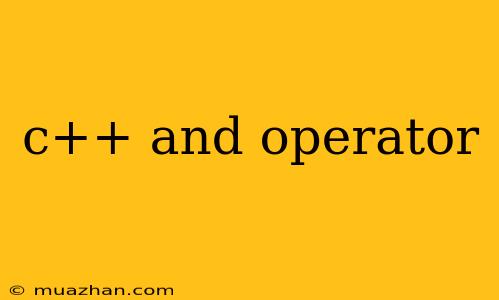C++ and the & Operator
The & symbol in C++ can be used for various purposes depending on the context. It can act as a bitwise AND operator, a reference operator, or a memory address operator. Let's explore each of these functionalities in detail.
Bitwise AND Operator
The bitwise AND operator (&) performs a logical AND operation on corresponding bits of two operands. It returns a 1 in a bit position if both bits in the corresponding position of the operands are 1. Otherwise, it returns a 0.
Example:
#include
int main() {
int x = 10; // Binary representation: 1010
int y = 5; // Binary representation: 0101
int result = x & y; // Binary representation: 0000
std::cout << "x: " << x << std::endl;
std::cout << "y: " << y << std::endl;
std::cout << "x & y: " << result << std::endl; // Output: 0
return 0;
}
Common Uses:
- Checking if a bit is set: You can use
&with a bit mask to check if a specific bit is set in a value. - Clearing bits: You can use
&with a bit mask to clear specific bits in a value. - Mask operations: The
&operator is crucial for various bit manipulation tasks, including masking, filtering, and isolating specific data.
Reference Operator
The reference operator (&) is used to create a reference, which is an alternative name for an existing variable. It allows you to modify the original variable directly through the reference.
Example:
#include
int main() {
int num1 = 10;
int& ref = num1; // 'ref' is a reference to 'num1'
std::cout << "num1: " << num1 << std::endl; // Output: 10
std::cout << "ref: " << ref << std::endl; // Output: 10
ref = 20; // Modifying 'ref' also modifies 'num1'
std::cout << "num1: " << num1 << std::endl; // Output: 20
std::cout << "ref: " << ref << std::endl; // Output: 20
return 0;
}
Key Points:
- References provide a way to work with variables indirectly.
- Any changes made to a reference are reflected in the original variable.
- References must be initialized with an existing variable.
Memory Address Operator
The address-of operator (&) returns the memory address of a variable. It is used in conjunction with pointers.
Example:
#include
int main() {
int num = 10;
int* ptr = # // 'ptr' stores the memory address of 'num'
std::cout << "num: " << num << std::endl; // Output: 10
std::cout << "Address of num: " << &num << std::endl; // Output: (memory address)
std::cout << "Value stored in ptr: " << *ptr << std::endl; // Output: 10
return 0;
}
Key Points:
- The address-of operator is used to obtain the memory location of a variable.
- It is crucial for working with pointers and accessing data directly in memory.
Conclusion:
The & operator in C++ is a versatile symbol with multiple functionalities. Understanding its different roles as the bitwise AND operator, reference operator, and memory address operator is essential for writing efficient and effective C++ code.
